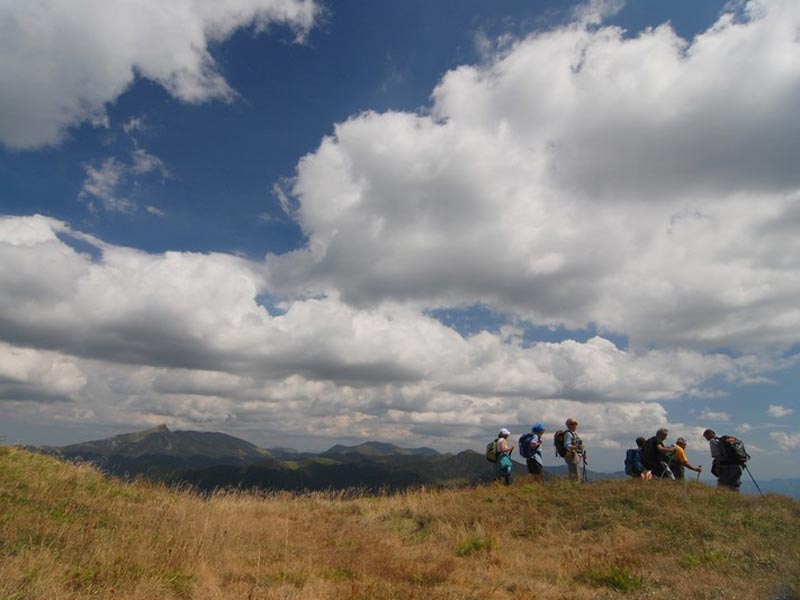Uphill and difficult, sometimes unpredictable like a forest path: that was the way leading to the establishment of Appennino Tosco Emiliano National Park.
It is easy to talk about "the Park"... now. Until the approval of the establishment law, the National Park had been a dream for some people, a nightmare for others.
Most people started to seriously discuss the issue when many obstacles had already been overcome, that is after the issuing of the Law 344 of 1997 when, to tell the truth, the descent had already begun... a difficult and uncertain descent, as mountain-lovers well know, but characterized by the belief that, sooner or later, we would get to the finishing line.
With the favorable opinion of the Municipal Councils for the first time in Italy, Law 344 led to the establishment of a National Park and its perimeter. This led to four years of debates and political struggles. Four long years, but also four fruitful years during which a new vision of the function of the Apennines territory on the two slopes was born: no longer merely hinterland and reservoir for industrial and urban areas (via Emilia and the coast), but a place with its own identity and with its own extraordinary environmental, productive, and human features.
A place where man, nature, and landscape could recover their balance, a place characterized by a new territorial price, modern economic vocations, an ancient and precious sense of community. A protected area, but also a territorial and human project.
The discussion that had begun many years before reached an end. On 11th November 1993, the local newspapers published an article written by me and Sergio Fiorini, President of Gigante Regional Park (later merged in the National Park): we wanted to open a public discussion, and what at the beginning was a first reflection, soon became an expression of intent. Briefly, we asserted that the economy of these valleys was changing. If our mountains had ever been characterized by a traditional production function, the latter had been lost and the solutions for this economic and social crisis had to be sought in an "ecological" economy practicing independent, innovative and at the same time very ancient activities: organic farming, characteristic livestock productions, forest production, holiday farming, and quality craftsmanship. The Apennines are an extraordinary reservoir of natural and cultural values, surrounded by one of the largest interregional production conurbations (Po Plain, Lucchesia, Versilia, and La Spezia). It was necessary to protect the Apennines to achieve long-term social and economic goals.
Some regional parks in Emilia and Apuane Regional Park in Tuscany were already heading for these goals, but had also to face a strong opposition. Moreover, they were suggesting an institutional and geographical fragmentation that could not provide a strong national environment and landscape connotation as a key resource for the future of the mountain ridges situated between the Po Plain, Versiglia, and Cinque Terre.
The law enforcement and the subsequent Park establishment were not only hindered by ancient social and cultural fear and resistance, but also by institutional conservative ideas. This opposition led to several discussions including lively meetings in the towns and villages of the Apennines. Already at that stage, the idea of the Park generated an important product for the territory: cultural, social, and political liveliness.
The establishment decree was issued on 21st May 2001 and defined a twisted and painful border, mirror of healthy democratic conflicts, but including four Provinces and two Regions, suitable to transform the new National Park in a connective tissue of a larger area.
It has been a hard uphill path which, like all the important mountain paths, has been a gratifying path.
Italy has been enriched with another big protected area in an essential crossroads for its climatic, landscape, and historical aspects.
The Euro-Mediterranean climatic border, the passes of the Apennines where you can enjoy the view of the Po Plain, the sea, Apuane, Pietra di Bismantova, the lands of Canossa and Malaspina, Emilia, Tuscany, and Liguria. Ridges and passes that, over the centuries, have united and divided people, different cultures and rules, from the Romans to the Gauls, from the Etruscans to the Ligurians, from the Lombards to the Byzantines. They were also the theater of the Resistance Movement and the Gothic Line, the frontier between the Germans and the Allied forces during the terrible winter of 1944.
In the past they were lands of pastures and charcoal piles, cattle breeding and poor mountain agriculture. Now they are tourist places in any season, but above all they still offer quality and local products: on the northern slopes, Parmigiano Reggiano or Parma Ham production chains shape both the economy and the landscape. On the southern slope, the air and the proximity of the sea and Apuane characterize the tastes and cuisine, influence the economy and human flows, tell another tale and show a landscape which, from season to season, offers the sequences of a great natural kaleidoscope.
The most watchful visitors, from the summit of Mt. Giogo or Pradarena Pass, or from the hundreds of panoramic terraces they can find along roads and trails, will realize that the Park borders - the borders you can see with your eyes and breathe while you take a rest - are larger and richer than the ones you can read from the cartography.
The interesting contents of this website are only the beginning for a thorough knowledge of this territory which, in only one day, offers strong borders and sudden openings, as well as extraordinary emotions and feelings.
Hon. Sen. Fausto Giovanelli
President of Appennino Tosco Emiliano National Park










